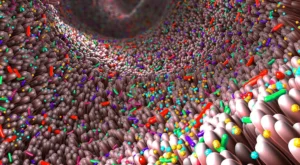Original Post Date: June 7, 2018

Professor Marika Mikelsaar, MD, PhD, Professor Emeritus in the department of Microbiology at the University of Tartu in Estonia, is credited with the discovery of Lactobacillus fermentum ME-3.
Estonia has a population of about 1.3 million people located in eastern Europe, bordering on Russia. The University was founded by King Gustavus Adolphus of Sweden in 1632, which makes it one of the oldest universities in the world. Although Estonia is a small country, the University of Tartu is rated academically as one of the top universities in the world. And it is in the top 1% of the world’s most cited universities in 10 scientific areas of research. For over 20 years, Professor Mikelsaar and her colleagues worked with the Russian space program studying the intestinal probiotics of Russian cosmonauts in zero gravity during extended space flights.
The Discovery of Lactobacillus fermentum ME-3
In 1994, Professor Bengt Björksten from the University of Linköping in Sweden was a visiting professor at the University of Tartu in Estonia. Professor Björksten noticed that very few Estonian children suffered from allergies, whereas the incidence of allergies among Swedish children was much higher. This motivated Professor Björksten to initiate a joint research project between doctors in the Department of Pediatrics at the University of Linköping with Professor Marika Mikelsaar and the Department of Microbiology at the University of Tartu.¹ Stool samples were collected from the Swedish and Estonian children to assess if differences in the bacteria in their gut microbiome might provide insights regarding the incidence of allergies. Significant differences were found in the intestinal bacteria of children who develop allergies compared to children who remain allergy free.²
During this collaborative study between Sweden and Estonia, over 200 strains of Lactobacillus bacteria were collected and identified. One of the stool samples, contained a previously unknown strain of bacteria, which was named Lactobacillus fermentum ME-3.
In 1996, a Dutch company engaged the University of Tartu’s microbiology department to test their collection of L. acidophilus strains to see if any exhibited antioxidant activity. This research ventured turned out to be disappointing because none of the tested strains of L. acidophilus exhibited any significant antioxidant properties.³ However, Professor Mikelsaar decided to also test the strain of Lactobacillus fermentum ME-3 that had previously been collected from a healthy Estonian child. When ME-3 was assessed, it expressed astoundingly high antioxidant activity. The scientists thought they had made a mistake. Repeated tests gave the same results, extremely high antioxidant activity. This mystery was finally solved when scientists in the U. of Tartu’s microbiology department discovered that ME-3 is capable of synthesizing glutathione.
The Benefits of Lactobacillus fermentum ME-3
After initially discovering that Lactobacillus fermentum ME-3 exhibits antioxidant activity, Professor Mikelsaar and her team of scientists initiated studies that began to reveal that ME-3 produces a wide range of additional health benefits. ME-3’s multiple benefits fall within several broad categories, including: antioxidant, immune support, inflammatory reponse balancing and detoxification. ME-3 has now been studied for over 20 years, and its unique health-promoting benefits are summarized below.
1. The Glutathione “Story”: Lactobacillus fermentum ME-3 increases glutathione levels. This is a remarkable story because glutathione is one of the most important antioxidants in the body. ME-3 is referred to as a “complete glutathione system” because it increases glutathione levels by three different mechanisms. ME-3 produces glutathione, it increases glutathione uptake into cells, and it also recycles, or regenerates oxidized or “used up” glutathione back to its reduced or “active” state. ME-3 is the only organism or substance we know that can increase glutathione levels by three different mechanisms simultaneously.⁴
Glutathione is made in every cell throughout the body. It neutralizes a wide range of free radicals and adequate levels are critical for good health. However, many exposers in today’s world deplete glutathione levels such as alcohol, artificial sweeteners, tobacco smoke, acetaminophen/Tylenol, toxic metals like mercury, artificial food dyes, and many common household chemicals. Also, the diet of many Americans is nutritionally deficient which contributes to low glutathione levels.
Every system in the body is influenced by glutathione levels, especially the immune system, the nervous system, the gastrointestinal system, and the lungs and liver. Hence, ME-3’s ability to increase glutathione levels is a benefit that can help improve the health of virtually everyone.
2. Powerful antioxidant: Antioxidants neutralize damaging free radicals, which promotes health and slows down the aging process. In addition to producing the antioxidant glutathione, ME-3 also produces a glutathione-containing antioxidant enzyme named glutathione peroxidase and glutathione reductase, which reactivates or recycles glutathione.⁵ As mentioned above, ME-3 is the only substance we know of to function as a “complete glutathione system” to synthesize, increase cellular uptake and recycle/regenerate glutathione.
Lactobacillus fermentum ME-3 produces another powerful antioxidant enzyme called manganese superoxide dismutase (MnSOD).⁶ MnSOD is the primary antioxidant enzyme in mitochondria which are the energy-producing sites within cells. Mitochondria consume over 90% of the oxygen used by cells which makes them especially vulnerable to oxidative free radical damage.⁷
Lactobacillus fermentum ME-3 provides additional antioxidant power because it also helps recycle antioxidants like vitamin C and vitamin E to their active forms. This has been documented in human clinical trials, in which people taking ME-3 orally for several weeks exhibit a 26% increase in total antioxidant activity.⁸
In summary, Lactobacillus fermentum ME-3 has been shown to have the highest Total Antioxidant Activity (TAA) and the highest Total Antioxidant Status (TAS) of any probiotic tested to date.⁹
3) Supports cardiovascular health: Lactobacillus fermentum ME-3 has been shown to lower triglycerides and increase levels of the “good” HDL-cholesterol. More importantly, ME-3 has been shown to substantially reduce levels of oxidized LDL-cholesterol.¹⁰
Since oxidized LDL-cholesterol is one of the greatest risk factors for heart disease, ME-3’s ability to reduce levels of oxidized LDL-cholesterol is a significant factor in promoting cardiovascular health.¹¹
4) Promotes detoxification: Since ME-3 substantially increases glutathione levels, scientists assume it will increase glutathione’s detoxification capabilities. Glutathione detoxifies numerous health hazards and toxic metals such as mercury, lead and arsenic. It is also involved in neutralizing and eliminating toxic air pollutants and many agricultural pesticides.¹²
5) Promotes liver health: The liver is the primary site for detoxification. The glutathione pathway is one of the mechanisms for neutralizing and removing a wide range of toxins from the body. Excess free radicals are generated during detoxification and ME-3’s ability to increase total antioxidant activity (TAA) means it will help protect the liver.¹³
6) Balancing inflammation: Lactobacillus fermentum ME-3 has been shown to reduce levels of several key pro-inflammatory markers such as high sensitivity C-reactive protein (hs-CRP) and interleukin 6 (IL-6), and it is also capable of stimulating production of the peptide adiponectin and of reducing levels of glycated hemoglobin or HbA1c.¹⁴ Since inflammation has been shown to be a major contributing factor in most of today’s chronic degenerative diseases, a substance that balances levels of inflammation can be a substance that helps to improve overall health.
7) Detoxifies Organophosphate Pesticides: Organophosphates, which are one of the most widely used pesticides world-wide, are highly toxic to the nervous system. They are commonly sprayed on commercial food crops and occur in many pesticide and insecticide products used in homes and gardens. They are also used in plasticizers, as antifoaming agents in lubricants and hydraulic fluids and flame retardants. Recently, more attention is being given to the detrimental effects of chronic low-level exposure, especially to children. Organophosphate exposure is now being linked to lower IQ, and conditions such as autism¹⁵ and ADHD¹⁶.
Lactobacillus fermentum ME-3 increases the production of an enzyme called PON1 which detoxifies organophosphates.¹⁷ A 2004 report stated the following, “Almost every person is, or has been, exposed to organophosphate insecticides in their home, work or environment.”¹⁸ It is very exciting to have a probiotic that helps protect against exposure to organophosphates.
8. Anti-Viral Activity: Glutathione and the key antioxidant enzyme glutathione peroxidase help reduce the inflammation, oxidative stress and free radical damage that occur during viral and immune challenges. However, glutathione levels are quickly depleted during viral infections. Hence, adequate glutathione levels are a key component of the body’s defense against viral infections¹⁹. Another important aspect of glutathione’s immune supportive activity is the fact that it helps prevent viral replication.²⁰
9. Survivability: To be effective, a probiotic must be able to withstand and survive exposure to the highly acidic conditions in the stomach and exposure to the digestive bile acids present in the small intestine. Studies show that L. fermentum ME-3 can survive at pH values ranging from 4.0 down to 2.5 (which is highly acidic) without a loss in viable cell count. Even at pH 2.0 the ME-3 strain survived for up to 6 hours. When exposed to bile acids, ME-3 survived for 24 hours without significant loss of live bacteria.²¹ Thus, Lactobacillus fermentum ME-3 can tolerate exposure to harsh acidity in the stomach as well as exposure to bile acids in the small intestine. Lactobacillus fermentum ME-3 is a survivor!
Lactobacillus fermentum ME-3 substantially increases glutathione levels which is an amazing new health “story.” Further, as reported above, ME-3 is a “multi-tasking” probiotic that offers a wide range of health-promoting benefits including antioxidant activity, improving cholesterol markers, detoxification of mercury and agricultural pesticides, anti-inflammatory and anti-viral activity and protection against gut pathogens.
Lactobacillus fermentum ME-3 is truly a breakthrough new probiotic that provides a wide range of benefits that can promote better health for everyone.
With its wide range of documented benefits
Lactobacillus fermentum ME-3 may qualify as
The strongest multi-function probiotic ever discovered.
References
- Mikelsaar M, Zilmer M. Lactobacillus fermentum ME-3 – an antimicrobial and antioxidative probiotic. Microb Ecol Health Dis. Apr 2009;21(1):1-27.
- Sepp E., et al., Intestinal microflora of Estonian and Swedish infants. Acta Paediatr. 1997 Sept;86(9):956-61.
- Mikelsaar M, Zilmer M. Lactobacillus fermentum ME-3 – an antimicrobial and antioxidative probiotic. Microb Ecol Health Dis. Apr 2009;21(1):1-27.
- Kullisaar T., et al., Complete glutathione system in probiotic Lactobacillus fermentum ME-3. Applied Biochemistry & Microbiology; Sep 2010, 46(5):481.
- Ibid., p. 481.
- US Patent 20040151708 A1: Strain of Micro-organism lactobacillus fermentum me-3 as novel anti-microbial and anti-oxidative probiotic. http://www.google.com/patents/US20040151708
- Kullisaar T, et al. Antioxidative probiotic fermented goats’ milk decreases oxidative stress-mediated atherogenicity in human subjects. British Journal of Nutrition. 2003; Vol. 90; pp.449-456.
- Kullisaar T, et al. Antioxidative probiotic fermented goats’ milk decreases oxidative stress-mediated atherogenicity in human subjects. British Journal of Nutrition. 2003; Vol. 90; pp.449-456.
- Hutt P, et al., Antagonistic activity of probiotic lactobacilli and bifidobacteria against entero- and uropathogens. Journal of Applied Microbiology. 2006; Vol. 100:1324-1332.
- Mikelsaar M, Zilmer M. Lactobacillus fermentum ME-3 – an antimicrobial and antioxidative probiotic. Microb Ecol Health Dis. Apr 2009;21(1):1-27.
- Holvoet P. Oxidized LDL and coronary heart disease. Acta Cardiol. 2004 Oct;59(5):479-84.
- Pastore A., et al., Analysis of glutathione: implication in redox and detoxification. Clin Chim Acta. 2003 Jul 1:333(1);19-39.
- Wu G., et al., Glutathione metabolism and its implications for health. J Nutr. 2004 Mar;134(3):489-92.
- US Patent WO 2014102692 A1: Method of treatment using lactobacillus fermentum me-3. http://www.google.com/patents/WO2014102692A1?cl=en
- University of California – Davis Health System. Association found between maternal exposure to agricultural pesticides and autism. Science Daily June 23, 2014.
- Bouchard MF, et al., Attention-Deficit/Hyperactivity Disorder and Urinary Metabolites of Organophosphate Pesticides. Pediatrics May 17, 2010; Songisepp E. Evaluation of technological and functional properties of the new probiotic Lactobacillus fermentum ME-3. Diss Med Univ Tartuensis; 2005.
- Mikelsaar M, Zilmer M. Lactobacillus fermentum ME-3 – an antimicrobial and antioxidative probiotic. Microb Ecol Health Dis. Apr 2009;21(1):1-27.
- Casida J, Quistad G., (2004). Organophosphate Toxicology: Safety Aspects of Nonacetylcholinesterase Secondary Targets. Chemical Research in Toxicology, Vol.17, No.8, pp. 983-992,
- Kayesh M, et al. Effects of oxidative stress on viral infections: an overview. npj Viruses. 2025;3:27.
- Wroblewska J, et al. The Role of Glutathione in Selected Viral Diseases. Antioxidants. 2023;12(1325.
- Songisepp E. Evaluation of technological and functional properties of the new probiotic Lactobacillus fermentum ME-3. Diss Med Univ Tartuensis; 2005.




